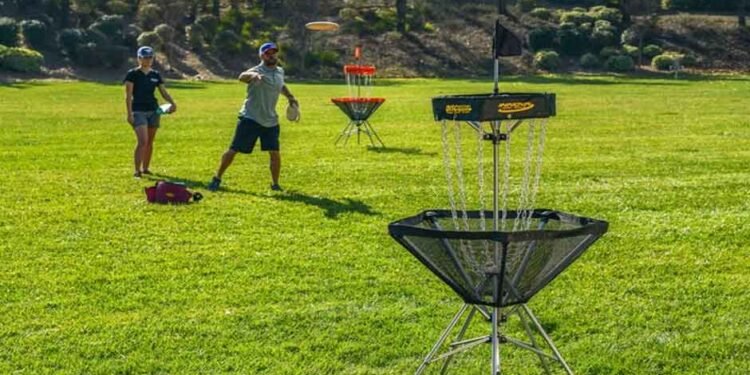Any disc golfer knows consistent putting transforms overall scores. While driving distance may capture highlights, honed putting ability saves crucial strokes on every hole. As with traditional golf, sinking more putts ultimately separates the lead card from intermediate packs in tournaments.
Beyond just using quality disc golf putters, players should optimize their putting form too. Adopting effective style and mechanics that fit your game early on avoids having to correct bad habits down the road. Let’s review some essential factors for finding your ideal putting routine.
Choosing the Best Putters for Consistency
While putter selection comes partly down to comfort and feel preference, their flight properties matter greatly for repeatability too. Overstable putter models fight gusting winds better while neutral flying options offer pinpoint accuracy. Certain plastic blends, rim configurations, and depths also promote improved grip and releases. Testing putters in various conditions reveals which discs perform most consistently for your style.
Premium Plastics For Durability
Many top professionals prefer premium plastic blends for their putting putters rather than base plastics. The added durability of premium plastics ensures a consistent grip and flight even as they beat in slightly over months of play. Models produced in premium plends like Jawbreaker, Latitude Luxury Elasto, and Dynamic Discs Lucid will keep performing reliably season after season.
Shallower or Beaded Rim Profiles
Some players achieve noticeably cleaner releases and accuracy with shallower, beaded rim putter profiles. The beaded rim helps center these putters naturally in the hand while throwing. Shallower discs tend to fly true to angles longer as well. Finding the right depth and rim configuration bolsters confidence to step up and run long putts knowing optimal stability will carry to the chains.
Determining Your Ideal Putting Stance
Just like driving form, putting stance anchors balance while chaining together fluid putting motions. Body positioning and footing largely correlate with accuracy as well. Testing a few common stances reveals which foundations offer the most consistency for your physiology and preferences.
Straddle Stances
Favored by top professionals like Paul McBeth, straddle stances widen bases wider than shoulders to brace against while keeping weight centered. This centralized footing pulls putting lines straight more easily while allowing added leverage from legs to achieve further distance. Wider straddle stances work especially well for spin putters incorporating lower body engagement. But they do take more practice to hone accuracy and timing properly at first.
Compact Stances
Other players achieve better results utilizing more compact, squared stances while putting. This keeps extraneous movement minimal while accurately aligning shoulders and stances in a direct line to the target. Compact postures naturally suit push-putting styles quite well, with less involvement from elaborate lower body motion during the throw. Having less to consciously coordinate timing-wise can directly benefit certain players.
Rotational Stances
Some hybrid stances take helpful aspects of both straddle and compact setups. These rotational stances still employ wider footing for increased balance and stability but rotate the upper core to achieve more fluid, dynamic putts. Such modified styles fuse attributes from traditional methods to create personalized advantages. Test out adjustments to see if rotational variations enhance your consistency.
Identifying Your Optimal Putting Method
While no universally “best” techniques exist across all disc golfers, two primary putting styles dominate among elite touring professionals currently. Finding which better suits your natural biomechanical strengths and preferences will shortcut improving consistency quicker.
Push Putting
This simpler form comes most naturally to newer players’ first learning. Using principally upper body motion, push putters shove the disc with palm and fingers towards the basket in a linear trajectory. This promotes central accuracy at shorter ranges but lacks some finesse needed to sustain accuracy for longer putts.
Spin Putting
By contrast, spin putters incorporate lower body force and rotational kinetic elements to propel discs with greater touch, finesse and power overall. Spin putters swing their arm similarly to a pendulum, generating momentum from legs and core rotation to achieve superior distance and accuracy. Spin styles connect all kinetic chains for fluid throwing function but require more dedicated practice to master properly.
Ingraining Muscle Memory With Drills
Whichever primary putting style you gravitate towards, consistent practice ingrains the sequenced motions into muscle memory. These drills and games build sound putting mechanics through enjoyable repetition.
Target Tape Drills
Placing a vertical line of Vivid marker tape on the center pole of the basket provides a clear visual accuracy marker while putting. This constant centered reference reinforces ideal release points and cleans pulling lines right to the chains.
Distance Progression Drills
Begin close to the basket and make five putts in a row at one distance before stepping back incrementally to challenge further ranges. Sinking putts confidently from 5 meters, 10 meters, 15+ meters, etc methodically builds confidence in distance abilities while solidifying mechanics.
Obstacle Courses
Setting up random obstacles like small traffic cones when putting adds engaging variety while mimicking real in-the-field challenges. Curve putts around trees, bushes or barriers to sharpen shaping lines and touch shots. Infuse your practice routines with fun creativity!
Finding your most optimal putting style along with throwing the best disc golf putters to match unlocks easy scoring possibilities. While casual weekend players may settle for inconsistent putting, competitors looking to trim strokes recognize mastering it delivers vital impact. Dedicate practice time towards honing your personal putting technique best suited for your body dynamics. Then watch birdies rack up consistently across the scorecard!
Conclusion
In conclusion, mastering the art of putting in disc golf is a critical component for lowering scores and elevating your game to the next level. By carefully selecting the right putters, understanding and refining your stance, and choosing a putting method that aligns with your natural strengths, you can significantly improve your consistency on the green.
Incorporating targeted drills into your practice routine not only helps in building muscle memory but also makes the process engaging and fun. Remember, the journey to becoming a proficient putter is a personal one, requiring patience, experimentation, and dedication.












